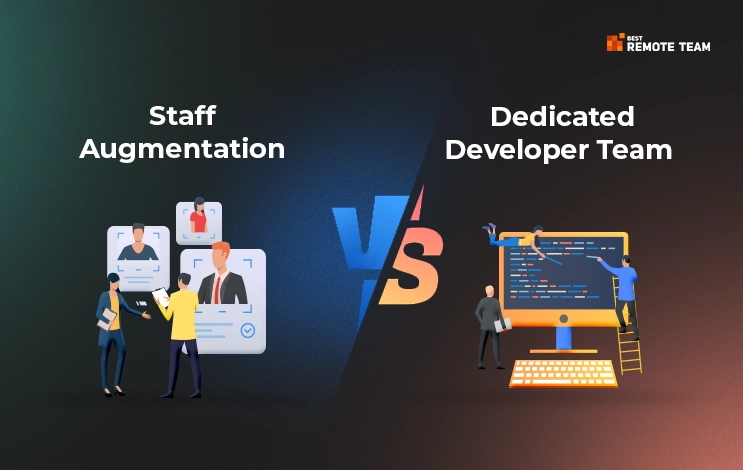What is a Dedicated Developers Team?
A dedicated developers team is a model of collaboration where a group of professionals with diverse skills and expertise is assigned exclusively to work on a specific project or set of tasks for an extended period, often for the entire duration of a long-term project or as an ongoing support unit. Companies can save 20-30% on development costs by using dedicated teams compared to in-house teams.
Key Characteristics Of A Dedicated Developers Team
- The team remains intact and focused solely on the client’s project, fostering higher commitment and enabling proactive project management.
- It provides a more holistic and business-oriented approach compared to staff augmentation, as the team has one set of business objectives in mind – the client’s.
- The team composition is tailored to the specific project requirements and can be dynamically adjusted as needed, including roles like project managers, business analysts, designers, developers, and QA engineers.
- The client maintains a high level of control and involvement in the development process, while the vendor handles the day-to-day team management.
- This model is well-suited for complex, long-term projects with evolving requirements, as the dedicated team can adapt and deliver results faster than an in-house team.
In contrast to staff augmentation, which is a more temporary and flexible arrangement, a dedicated developers team represents a long-term, self-contained unit focused on a particular project or function. The choice between the two depends on factors like project duration, resource requirements, and the level of control desired by the organization.
The Dedicated Team Model: How It Works and Why It Matters
- A dedicated team is a group of professionals with diverse skills (developers, designers, QA, PMs, etc.) assigned exclusively to work on a specific project for an extended period.
- The team remains intact for the entire project duration or as ongoing support, fostering higher commitment and enabling proactive project management.
- The dedicated team works independently as a self-contained unit, with a dedicated project manager or team lead.
- The client maintains a high level of control and involvement in the development process, while the vendor handles day-to-day team management.
- Dedicated teams are well-suited for complex, long-term projects with evolving requirements, as the team can adapt and deliver results faster than an in-house team.
Benefits of a Dedicated Developers Team
- Increased productivity as the team focuses solely on one project.
- Ideal for long-term projects and ongoing support.
- Foster better team-wide communication as the team remains intact.
- Multidisciplinary approach with a mix of skills tailored to the project.
- Proactive project management with a dedicated team lead.
- Higher commitment from team members focused on one project.
- Adaptability to evolving project requirements.
- Cost-effectiveness for long-term engagements due to increased productivity.
When to Use the Dedicated Team Model?
- Long-Term Projects: Ideal for projects with a longer duration that require ongoing development, maintenance, and support.
- Complex Projects: Suitable for projects demanding continuous attention, specialized expertise, and cohesive team effort.
- Scalability: When planning to scale operations significantly, a dedicated team provides the necessary stability and expertise.
- Focused Engagement: When you need a team that is fully engaged and aligned with your project goals, ensuring higher productivity and commitment.
- Consistent Team: Beneficial when a stable, long-term team is needed to maintain continuity and a deep understanding of your business and project.
Common Challenges Solutions Of The Dedicated Team
1. Higher Initial Costs
Solution: Ensure a detailed cost-benefit analysis is conducted to justify the initial investment by emphasizing long-term project benefits and outcomes.
2. Less Direct Control
Solution: Establish clear communication channels and regular updates to maintain oversight and ensure alignment with project goals.
3. Integration with Existing Processes
Solution: Implement a structured onboarding process that includes training on your company’s culture, processes, and tools to ensure seamless integration.
4. Dependency on External Providers
Solution: Choose a reputable service provider with a proven track record and establish a detailed contract outlining expectations and performance metrics.
People also read: Offshore VS Onshore Teams
What is Staff Augmentation?
A survey conducted in 2023 found that 77% of companies worldwide find it challenging to locate qualified candidates. 78% work in the IT sector. Staff augmentation is a business strategy where organizations temporarily hire external professionals or teams to supplement their existing workforce and address specific skill gaps or project needs. Types of staff augmentation allow companies to scale their workforce up or down flexibly based on project requirements.
Key Characteristics Of Staff Augmentation Include:
- Hiring temporary or contract workers to work alongside the in-house team.
- Accessing specialized skills and expertise that may be lacking internally.
- Integrating external resources seamlessly into existing processes and workflows.
- Maintaining control over the project while the vendor manages the augmented staff.
- Providing an alternative to traditional hiring for short-term or project-based needs.
Companies often leverage staff augmentation to quickly ramp up their team to meet project demands, address skill gaps, or handle workload fluctuations. It offers flexibility, cost-effectiveness, and access to global talent pools.
The Staff Augmentation Process Typically Involves:
- Initial contact between the client and vendor to discuss requirements.
- Vendor selecting suitable specialists based on client needs.
- Conducting interviews to assess skills.
- Signing a contract and onboarding the augmented staff.
Staff augmentation differs from other outsourcing models like dedicated teams or managed services in the level of control retained by the client. It is best suited when the client has an existing team, needs to expand quickly, has tech-savvy managers, requires high-level skills, and wants direct communication with the augmented staff.
The Staff Augmentation Model: How It Works and Why It Matters
- Staff augmentation involves hiring external professionals or teams on a temporary or project-based basis to supplement an organization’s existing workforce.
- It allows companies to access specific skills and expertise when needed, scaling their workforce up or down based on project requirements.
- The external resources work collaboratively with the internal team, integrating seamlessly into existing processes and workflows.
- Staff augmentation is managed by the client’s existing management structure.
- It is best suited for short-term projects requiring quick access to specific skills, as it provides flexibility in scaling the workforce.
Benefits of Staff Augmentation
- Quick access to specialized skills and expertise on an as-needed basis.
- Flexibility to scale the workforce up or down based on project needs.
- Cost-effectiveness as you only pay for the specific skills and hours needed.
- Reduced hiring efforts as the vendor handles recruiting and onboarding.
- Ability to quickly fill skill gaps in an existing team.
- Ideal for short-term projects with tight deadlines.
- Allows focusing on core business while the vendor manages staffing.
When to Use the Staff Augmentation Model?
- Short-Term Projects: Perfect for projects with a limited scope or duration, where temporary expertise is required.
- Skill Gaps: When specific skills are needed temporarily, such as for a particular phase of a project, staff augmentation fills these gaps efficiently.
- Workload Peaks: To handle temporary increases in workload without committing to long-term hires, staff augmentation provides the needed workforce flexibility.
- Flexibility: Allows for easy scaling of the workforce up or down based on project demands, providing cost-effective solutions for fluctuating needs.
- Quick Expertise: Useful when you need to quickly bring in expertise to meet tight deadlines or address urgent project requirements.
Common Challenges and Solutions of the Staff Augmentation Model
1. Integration with In-House Team
Solution: Facilitate team-building activities and provide clear guidelines to ensure temporary staff quickly adapt to your company’s culture and processes.
2. High Turnover and Continuity Issues
Solution: Maintain a knowledge transfer process and documentation to ensure continuity despite turnover, and consider longer-term contracts for key roles.
3. Management and Coordination
Solution: Use project management tools and practices to effectively manage and coordinate between in-house and augmented staff.
4. Consistency in Quality
Solution: Implement strict screening processes for hiring augmented staff and provide continuous feedback to ensure high-quality performance.
By addressing these challenges with proactive solutions, both the dedicated team and staff augmentation models can be effectively leveraged to meet project goals and deliver successful outcomes.
How to Decide on the Right Team Structure: Dedicated Team vs. Staff Augmentation
Here’s a detailed comparison of the various factors in paragraph form:
1. Cost
In-house teams generally incur the highest costs due to salaries, benefits, office space, equipment, and other overhead expenses. This makes maintaining an in-house team a significant financial commitment for a company. In contrast, outsourcing can be more cost-effective, with variable costs depending on the location and reputation of the service provider. While outsourcing typically reduces expenses compared to in-house teams, there can be hidden costs related to quality control and coordination. Remote teams offer a middle ground, with lower costs than in-house teams due to savings on office space and flexible salary structures that can take advantage of lower-cost locations.
2. Hiring Efforts
Recruiting for in-house teams demands considerable effort, encompassing the entire recruitment, interviewing, and onboarding process. This often requires dedicated HR resources to manage effectively. Outsourcing reduces the burden of hiring since the service provider is responsible for their staff. However, there is still an initial effort needed to identify and select a reliable outsourcing partner. Remote teams require moderate hiring efforts, similar to in-house recruitment but with the additional challenge of assessing candidates’ ability to work effectively in a remote environment.
3. Communication and Collaboration
Communication and collaboration are generally more straightforward with in-house teams due to physical proximity, which allows for face-to-face meetings and quick interactions. Outsourcing can introduce challenges such as time zone differences and cultural barriers, necessitating robust communication tools and regular updates to ensure alignment. Remote teams also rely heavily on digital communication tools. While time zone differences can pose challenges, these can often be mitigated by flexible schedules and well-established communication protocols.
4. Accessibility
In-house teams offer high accessibility, with team members present in the same location, facilitating immediate interactions. Outsourcing typically limits direct access, requiring scheduled meetings and updates to stay informed. Remote teams’ accessibility can vary depending on time zone alignment and agreed working hours, which may require more planning to ensure availability.
5. Flexibility
In-house teams usually have limited flexibility, bound by fixed working hours and physical location. Outsourcing provides higher flexibility, allowing companies to scale operations up or down based on project needs without long-term commitments. Remote teams offer significant flexibility regarding working hours and locations, making it easier to attract a diverse and potentially more skilled talent pool.
6. Management
Managing in-house teams is generally more straightforward, with direct control and oversight possible. This, however, requires dedicated management resources to ensure productivity and engagement. Outsourcing shifts much of the management responsibility to the service provider, though oversight is still necessary to maintain quality and alignment with business objectives. Remote teams necessitate effective remote management practices and tools to ensure team members remain productive and engaged despite the physical distance.
7. Visibility
In-house teams provide high visibility into day-to-day activities and progress, allowing for real-time adjustments and direct feedback. Outsourcing can reduce visibility, depending largely on the transparency and reporting practices of the service provider. Remote teams offer medium visibility, which can be significantly improved through the effective use of project management and communication tools.
8. Onboarding
Onboarding new hires in-house involves an extensive process to integrate them into the company culture and operational processes. In contrast, outsourcing requires minimal onboarding as the service provider has established processes for their employees. Onboarding remote team members requires a structured and comprehensive approach to ensure they are smoothly integrated and quickly become productive despite the physical distance from the main office.
9. Skills
The skills available within in-house teams are typically limited by the local talent pool and the company’s ability to attract and retain skilled employees. Outsourcing offers access to a broader range of skills and expertise from specialized providers, often at a lower cost. Remote teams provide access to a global talent pool, making it easier to find niche skills and expertise that might be scarce locally. This global reach can be a significant advantage for companies looking to innovate and stay competitive.
This comparison highlights the strengths and weaknesses of each approach, helping organizations decide based on their specific needs and constraints.
Which is Better: Dedicated Team or Staff Augmentation?
Choosing between staff augmentation and a dedicated team depends on project needs. Staff augmentation adds temporary skilled personnel to your existing team, offering flexibility and cost-effectiveness for short-term projects or specific skill gaps. It allows for quick expertise integration but may face challenges with staff adaptation and continuity. This approach suits short-term needs, skill gaps, and peak workloads.
Conversely, a dedicated team involves professionals from a service provider working exclusively on your project. This setup provides full engagement, tailored expertise, and long-term stability, ideal for complex, ongoing projects. Though it comes with higher initial costs and less direct control, it reduces management burden and ensures consistent focus.
Choose staff augmentation for short-term flexibility and immediate skill needs. Opt for a dedicated team for long-term projects requiring continuous effort and specialized skills. Evaluate project scope, duration, budget, and integration needs to make the best decision.
Conclusion
The engagement model is crucial in ensuring the project’s success. The model you choose should fit your project needs, budget, and expected outcomes. Staff augmentation works when you have an in-house team and want to support them with the necessary resources and capabilities.
However, you can opt for dedicated hiring if you don’t have an in-house team and need help with your technology requirements. You can partner with a software development company that can help enhance the user’s experience and offer you control of the project.
Depending on what works best for you, you can go with nearshore or offshore outsourcing. Best Remote Team helps you with recruiting and staffing needs. We can help you with staff augmentation and hiring dedicated teams for your needs.




